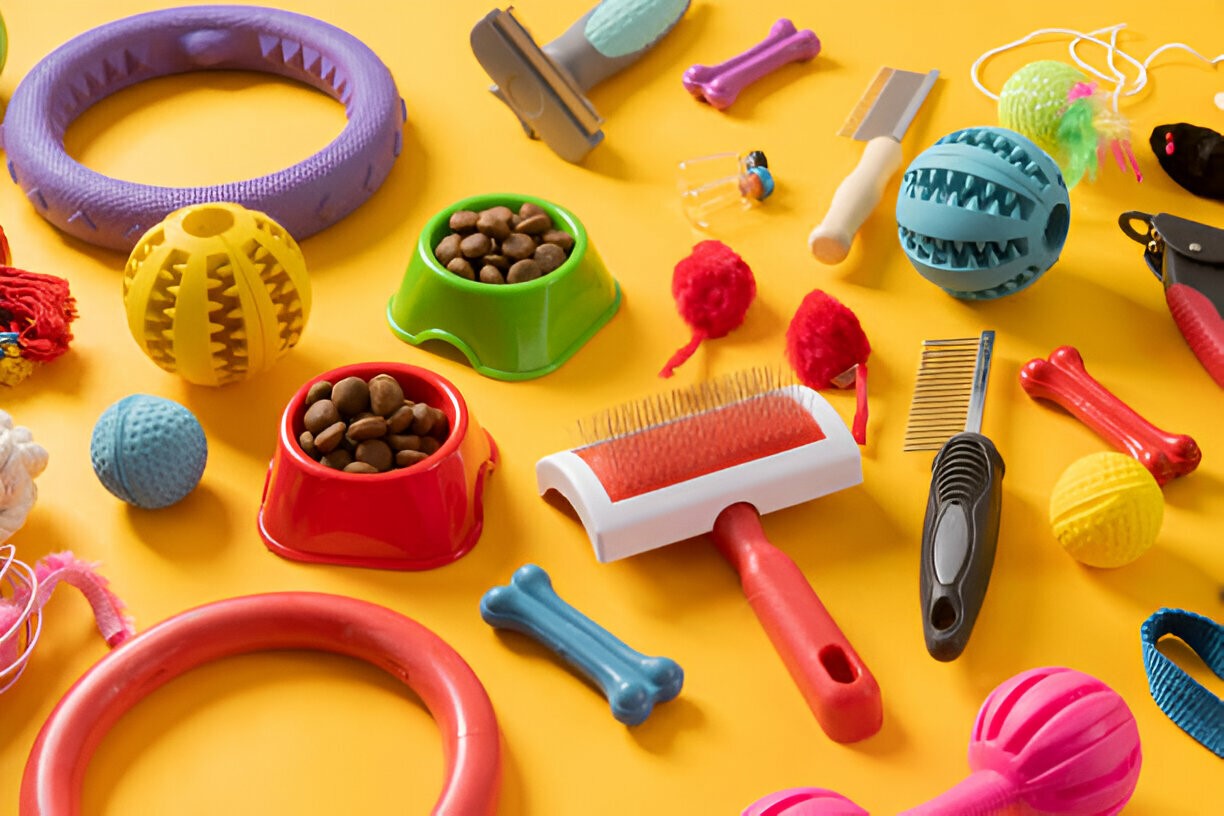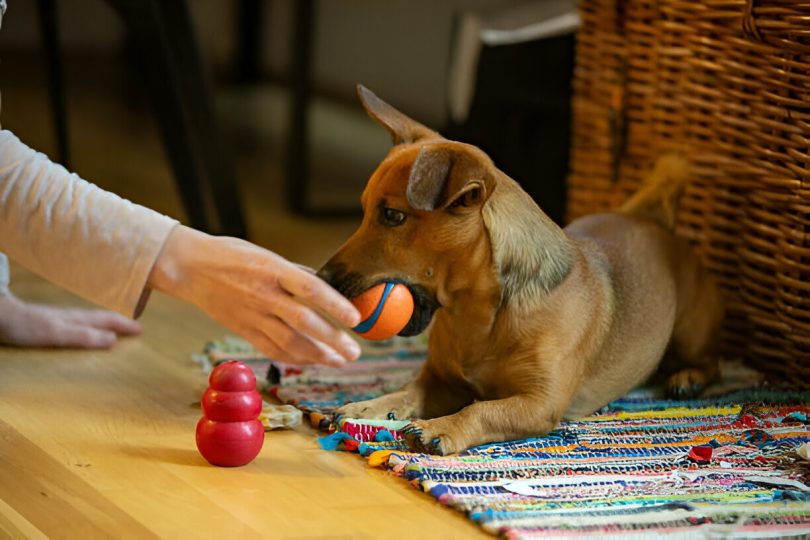Dogs are super smart and curious creatures, which means they love playing with brain-stimulating puzzle toys. These toys are interactive and challenge your dog’s mind, giving them a fun and rewarding experience. Plus, they can help manage your dog’s behavior and keep them entertained. In this article, we’ll dive deeper into the world of puzzle toys for dogs. We’ll talk about the benefits, different types, and how you can include them in your dog’s daily routine.
What are Dog Puzzle Toys?
Puzzle dog toys that dispense treats are a fun and engaging way to provide your dog with both mental and physical exercise. These toys require your dog to solve a puzzle to receive a treat, which can be hidden inside or dispensed as your dog interacts with the toy. This interactive experience keeps your dog engaged and entertained, stimulating their mind and encouraging positive behaviors.
Benefits of Brain Stimulating Toys for Dogs
Mental Stimulation
Brain-stimulating toys provide a challenging and engaging experience for your dog. They stimulate your dog’s brain by requiring them to solve puzzles, figure out how to access treats, and engage in complex play activities.
Prevents Boredom
Boredom can lead to undesirable behaviors such as excessive barking, digging, or chewing. Brain-stimulating toys offer a constructive outlet for your dog’s energy and curiosity, keeping them entertained and satisfied.
Slower Eating
Puzzle toys that dispense treats can be particularly beneficial for fast eaters. By slowing down the rate at which your dog consumes their food, you can help improve digestion and reduce the risk of bloating and other digestive issues.
Promotes Positive Behavior
Dogs that are engaged and stimulated are less likely to exhibit destructive behaviors. Puzzle toys can help alleviate anxiety and stress, leading to a calmer, happier dog.
Improves Cognitive Function
Regular use of puzzle toys can help maintain and improve your dog’s cognitive abilities as they age.
Reduces Destructive Behavior
By providing your dog with an engaging and rewarding activity, brain-stimulating toys can help curb destructive behaviors. When your dog is busy with a puzzle toy, they’re less likely to chew on furniture or other household items
Provides Exercise for the Mind and Body
Many brain-stimulating toys require both physical and mental effort. For instance, a dog may need to nudge or paw at a puzzle toy to reveal a treat, providing a combination of mental and physical exercise.
Types of Dog Puzzle Toys

Puzzle toys come in various shapes, sizes, and levels of complexity, providing different challenges for your dog’s mind and play style. These are some of the most common types of puzzle toys for dogs:
1. Food-Dispensing Toys
These toys hide treats or kibble inside and require your dog to manipulate the toy to access the reward. Examples include:
- Treat Balls: These are spherical toys with holes that dispense treats as the dog rolls or nudges the ball.
- Kibble Dispensers: Similar to treat balls, these toys release kibble as your dog plays with them, making mealtime more interactive and fun.
- Interactive Feeders: These feeders have compartments and obstacles that require your dog to work for their food, slowing down their eating and making mealtime a mentally stimulating experience.
2. Hide-and-Seek Toys
These toys involve hiding treats or smaller toys within compartments or layers of the main toy. Your dog must use their problem-solving skills and sense of smell to find and retrieve the rewards. Examples include:
- Puzzle Boards: These are flat boards with sliding, flipping, or rotating parts that hide treats underneath.
- Compartment Toys: These toys have various compartments or drawers where you can hide treats, requiring your dog to figure out how to open them.
3. Snuffle Mats
These mats simulate a foraging experience by hiding treats within fabric strips or textures. Dogs can use their sense of smell to search and find the hidden treats, satisfying their natural instincts.
4. Puzzle Mats
Similar to snuffle mats, puzzle mats incorporate different textures and hidden pockets to hide treats. Dogs enjoy sniffing and searching for the rewards.
5. Interactive Game
These games present a series of tasks or challenges that your dog must complete to access the treats. They may involve flipping switches, pulling levers, or pushing buttons.
6. Multi-Level Puzzles
These toys offer varying levels of difficulty, requiring dogs to work through different stages to reach the final reward. Multi-level puzzles are great for keeping your dog engaged and challenged.
7. Stuffed Animals and Plush Toys
Some plush toys incorporate puzzles by hiding squeakers, treats, or other interactive elements within. Dogs enjoy finding and extracting these hidden surprises.
How to Choose the Best Puzzle Toy for Your Dog?
Selecting the right puzzle toy for your dog involves considering a variety of factors to ensure the toy is engaging, safe, and suitable for your dog’s needs and preferences. Here are some key points to keep in mind when choosing the perfect puzzle toy for your furry friend.
1. Size and Breed
Consider your dog’s size and breed when choosing a puzzle toy. Smaller dogs may prefer toys that are easy to handle, while larger breeds may require more durable options. Make sure the toy is appropriately sized to prevent choking hazards and ensure safe play.
2. Difficulty Level
Start with puzzle toys that match your dog’s skill level. For beginners, opt for simpler toys with fewer components or easier tasks to solve. As your dog becomes more experienced, you can introduce more complex toys that offer greater challenges.
3. Materials and Durability
Choose puzzle toys made from safe, non-toxic materials that can withstand your dog’s chewing and play. Look for durable options that won’t break or splinter easily, especially if your dog is an aggressive chewer.
4. Safety
Prioritize your dog’s safety when selecting a puzzle toy. Avoid toys with small parts that could pose a choking hazard, and opt for toys that are designed specifically for dogs to minimize the risk of injury.
5. Interactive Features
Consider the interactive features of the puzzle toy and how they align with your dog’s preferences. Some dogs may enjoy toys with moving parts, while others may prefer toys that require more mental stimulation, such as scent-based puzzles.
6. Personal Preferences
Take into account your dog’s play style and preferences. Some dogs may prefer toys that dispense treats, while others may enjoy toys that involve hiding or retrieving objects. Choose a puzzle toy that matches your dog’s interests to maximize their enjoyment.
7. Versatility
Look for puzzle toys that offer versatility and can be used in different ways to keep your dog engaged. Toys with adjustable difficulty levels or multiple play modes can provide ongoing entertainment and mental stimulation for your dog.
8. Reviews and Recommendations
Read reviews and seek recommendations from other dog owners or pet professionals to get insights into which puzzle toys are highly rated and suitable for your dog’s needs.
Tips for Introducing Puzzle Toys to Your Dog’s Routine
Introducing puzzle toys to your dog’s routine can be an exciting and rewarding experience for both you and your dog. However, it’s important to introduce these toys gradually and thoughtfully to ensure your dog remains engaged and enjoys the experience. Here are some tips to help you integrate puzzle toys into your dog’s routine:
- Start Slowly: Begin with simple puzzle toys that are easy for your dog to understand and solve. This helps build their confidence and keeps them motivated to play. As they become more experienced with puzzles, you can introduce toys with higher difficulty levels.
- Supervise Playtime: Always supervise your dog while they play with puzzle toys, especially when introducing new toys for the first time. This allows you to monitor their progress, ensure they’re using the toy safely, and intervene if needed.
- Encourage Exploration: Guide your dog through the puzzle by demonstrating how it works or showing them how to access the treats. This helps your dog understand the goal of the toy and keeps them engaged.
- Rotate Toys: To keep your dog interested and prevent boredom, rotate different puzzle toys in and out of their routine. This variety keeps the experience fresh and exciting for your dog.
- Adjust Difficulty: If a puzzle toy is too easy or too challenging for your dog, adjust the difficulty level. For example, you can add or remove obstacles, use different types of treats, or switch to a different toy to match your dog’s abilities.
Common Mistakes to Avoid with Puzzle Toys
While puzzle toys can provide numerous benefits for your dog, there are common mistakes that owners can make when introducing these toys to their pet’s routine. By being aware of these pitfalls, you can ensure a safe and enjoyable experience for your dog. Here are some common mistakes to avoid with puzzle toys.
Choosing the Wrong Difficulty Level
Starting with a puzzle toy that is too challenging can frustrate your dog and discourage them from engaging with the toy. Conversely, if the puzzle is too easy, your dog may lose interest quickly. Begin with simpler puzzles and gradually increase the difficulty as your dog becomes more skilled.
Lack of Supervision
Always supervise your dog while they play with puzzle toys, especially when introducing a new toy. This allows you to intervene if your dog struggles, becomes overly frustrated, or attempts to chew or swallow parts of the toy.
Forgetting to Monitor Wear and Tear
Puzzle toys can wear down over time, especially if your dog is an aggressive chewer. Regularly inspect the toy for signs of damage or wear and replace it if necessary to avoid the risk of your dog ingesting broken pieces.
Overusing Treats
While puzzle toys that dispense treats can be an effective way to motivate and engage your dog, overusing treats can lead to weight gain or digestive issues. Use healthier, low-calorie treats and adjust your dog’s diet accordingly to account for the extra treats.
Not Rotating Toys
Providing your dog with the same puzzle toy repeatedly can lead to boredom. Rotate different puzzle toys in and out of your dog’s routine to keep their play experience fresh and engaging.
Ignoring Signs of Stress or Frustration
If your dog shows signs of stress, such as excessive panting, whining, or avoiding the toy, it may be too challenging for them. Take a break and assess whether the toy is appropriate for your dog’s abilities.
Skipping Training and Guidance
Introducing puzzle toys without guidance can confuse your dog. Spend time teaching your dog how to interact with the toy, offering praise and encouragement as they solve the puzzle.
Relying Solely on Puzzle Toys
While puzzle toys provide great mental stimulation, they should not replace other forms of exercise and social interaction. Continue to provide your dog with regular physical activity and social playtime with you or other dogs.
Conclusion
Puzzle dog toys that dispense treats can significantly enhance your dog’s playtime and overall quality of life. These toys offer numerous benefits, from keeping your dog mentally stimulated to preventing boredom and destructive behaviors. By choosing the right puzzle toy for your dog, introducing it gradually, and keeping their playtime fresh and exciting, you can provide a fulfilling and rewarding experience for your furry friend. You can lear more about dogs training and other stuff here at The Pets Rise.
As you embark on this journey of incorporating puzzle toys into your dog’s routine, remember to be patient and attentive to your dog’s needs and preferences. Your dog will not only enjoy the mental challenge but also develop new skills and a stronger bond with you. Embrace the adventure of puzzle play and watch your dog’s enthusiasm and confidence grow!







